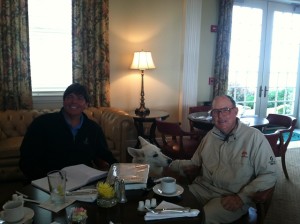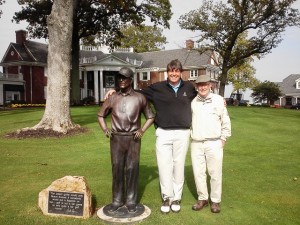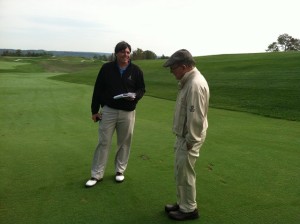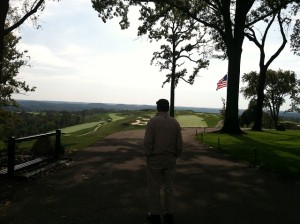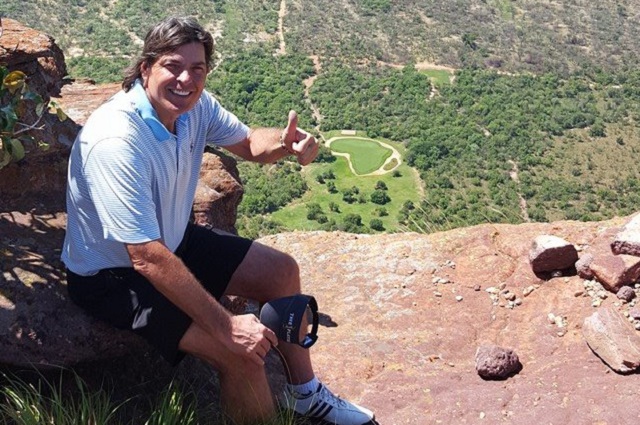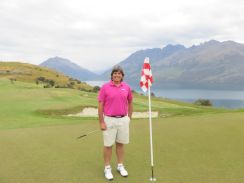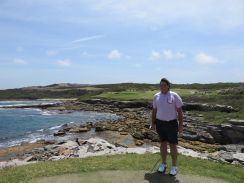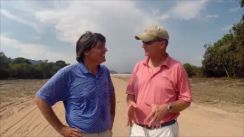Golf Writer Andy Reistetter experienced something truly special- a day with golf’s legendary golf course architect Pete Dye at his signature golf course- The Pete Dye Course at Indiana’s premier French Lick Resort. The inspirational encounter included a two-hour conversational interview, lunch and a walking tour of the course with Pete and Golf Superintendant Russ Apple to check out recently completed modifications and to ponder others to come. Join Reistetter as he reminisces about “the long view” of Pete Dye and what he means to our golfing lives.

No. 9 on the Pete Dye Course at the French Lick Resort in Indiana. (Photograph courtesy of Dave Harner).
Pete Dye is at home in Indiana and that is where he has created the Masterpiece of all of his golf course designs- an altar upon which all Dye lovers will worship his genius for all of golfing eternity. Ever since man has lived on the Earth he has sought the highest point to be close to Heaven. Dye found his place in the rolling hills of Southern Indiana and created “the long view” through which future generations will come to know the man at the heart of this era of golf course design.
Dye is nothing more than a simple and humble man who works tirelessly, without technology for the most part, preferring sketches on the back of napkins and imprinting his vision with those he works with to build great designs like the Stadium Course at TPC Sawgrass, Kiawah Island and Whistling Straits.
When asked how he figured out the puzzle and found the sweet spot of risk-reward design that challenged the players, pleased golf television producers and entertained us mere amateurs and lovers of the game his reply is simple and surprising, “I don’t know, I have no idea, you tell me.” Though in his uncanny style he delivered what everyone wanted. Players rose to the higher standard of competitive course design, producers delivered the beauty of the courses and the drama of competition and we willingly pay big bucks to play Dye’s courses.
There is no question of Dye’s contributions to the game as evidenced by the awards and recognition given to him- including the Old Tom Morris Award from the Golf Course Superintendents Association of America (GCSAA), the PGA TOUR’s Lifetime Achievement Award and his induction into the World Golf Hall of Fame. The quiet, people and dog loving prophet aced the hole of modern golf course design before we ever imagined in our minds.
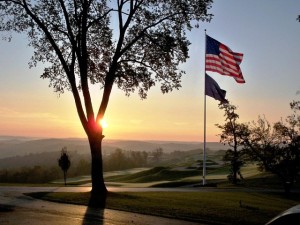
Pete Dye designed in “the long view” at French Lick and it is spectacular! PHOTO CREDIT: Dave Harner
One wonders how this all came to be? If you ask Pete his reply again is “I don’t know, I have no idea, you tell me.” But he is an open book and having had an opportunity to read his person up close and personal here is what I surmise.
Fate had something to do with it. In the early 1920s Pete’s father was driving to Washington, D.C. when his car broke down. Stranded, he stayed at the Summit Inn above Uniontown, Pennsylvania where he went out to play a few holes of golf for the first time on their 9-hole mountaintop course and got hooked on the game. Upon returning home to Urbana, Ohio he built a 9-hole golf course of his own and a few years later Pete was born. He was watering and cutting greens by age 7, the greens superintendant by age 16 and burnt out all the greens during his second year on the job.
Pete said his father volunteered him to for the Army and he trained to be a paratrooper. Stationed at Fort Bragg, North Carolina he became the superintendent at the base golf course. The course was designed by Donald Ross and had sand greens. No one knows if he burnt them out. Dye would drive the 35 miles with his superiors over to Pinehurst to play golf. There he would find and meet Donald Ross who like himself would become one of only five golf course architects in the Hall of Fame (the other three being Charles Blair Macdonald, Alister MacKenzie and Robert Trent Jones Sr.)
Another stroke of fate was that a neighbor of Pete’s in Urbana had a son that went to The Ohio State University and became friends with Jack Nicklaus. Dye had an expert pointer dog and the boys would borrow the dog when they went hunting. Jack likes to tell the story that at age 18 his big break was that he beat a 32-year old Pete Dye 4&3 in a match in the Trans-Mississippi Amateur to earn an invitation to the Masters. Pete likes to remind people that he beat Jack at Inverness when Jack made his major debut at age 16 in the 1957 U.S. Open in Toledo. He leaves out the fact that the boy wonder shot 80-80 and missed the cut same as he did. As a team they designed and built Harbour Town Golf Links in Hilton Head Island, South Carolina in 1969 and from there their design careers took off.
Pete Dye was a keen amateur golfer and qualified for the 1963 British Amateur Championship at St. Andrews. Only a few years into the golf design business his thorough tour of the classic Scottish golf courses would mold him into the golf course designer that he is. Sort of a Renaissance man golfing wise he incorporated the historic pot bunkers, use of wooden bulkheads and smallish sized slanted greens into modern courses.
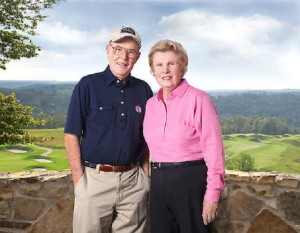
Alice & Pete Dye with the long view of their course at French Lick in the background. PHOTO CREDIT: Dave Harner
Like all successful men there is a strong woman behind Pete Dye and her name is Alice. They met in college at Rollins near Orlando and have been married for 62 years. A champion golfer in her own rite she has played with the likes of Babe Zaharias, Patty Berg, even Sam Snead and Byron Nelson. She won the Indiana State Amateur nine times, Florida’s three times as well as the U.S. Senior Women’s twice. Maybe it is Pete standing behind Alice? Some would say she worked behind the scenes and is the one that brought the PGA Championship to Dye’s Whistling Straits and Kiawah island courses. In reality they are side by side, dynamic golf architecture team both previous presidents of the GCSAA and have collaborated on most “Dye” designs, if not all in one way or another.
Pete’s first question of his first call down to Dave Harner the Director of Golf at French Lick says it all about the woman and the dog in Pete’s life. Pete asked, “Do you have ticks down there?” Dave, thinking he was talking about himself, said “yeah they will get on you but you will know it.” Dye responded, “No not me, my dog.” He had taken Sixty down to Kentucky and brought him back with ticks which upset Alice. After walking the golf course the day I met him, Pete personally washed down Sixty and closely inspected him to insure Alice would be happy.
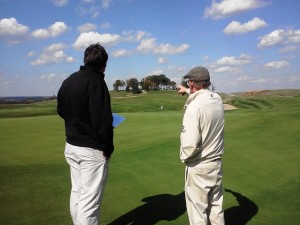
Pete Dye showing me the long view and his unmatched and insightful golf course architecture perspectives… what a day!
Fate for sure but hard work and talent performed consistently over a long period of time has made Pete Dye the renown golf course architect that we all know, love and love to hate at times. His genius at French Lick is evident as you drive though the gates. The road meanders a bit through the course and finds its way up to an old mansion that is converted into a clubhouse. The view goes on forever in all directions from the highest point. By raising fairways and lowering tree lines Dye insured the same view on all 18 holes that encircle the majestic clubhouse. At French Lick, in perhaps his last Masterpiece, Pete Dye has created “the long view.”
The Pete Dye Course is unique, a true links course on a mountaintop with no trees and natural stone cart paths winding through hillocks and crisscrossing the entire golf course. The view behind the infinity green on No. 6 goes on forever, maybe even 60 miles on a clear day. No houses to be seen anywhere. No two bunkers are alike including the “volcanic” ones atop hillocks. The only thing that is predictable is the beautiful color contrast between fairway and rough and the challenge to put the ball in the fairway, on the green and finally into the hole.
It is interesting to note that nearly 100 years after his father’s car broke down and he came to golf atop a mountaintop course with a sixty mile view on the fourth hole, son Pete Dye brought his dog Sixty and has majestically constructed the same awed sense of infinite spirit at French Lick. This course is truly the gem of not only the Pete Dye Trail in Indiana but surely all of Dye’s vast portfolio.
I am guessing a PGA Championship there in 2020- resulting in the long view with perfect vision!
Five Tidbits on Pete Dye from the interview:
1. What would Mary Smith think of this hole? This is a common refrain of Pete’s as he muses and works as a golf course designer. It references his wife Alice Dye who has a weekly game with her friends at Crooked Stick who don’t break 100. Perhaps one was named Mary Smith? A bulldozer was working on the bunker in the middle of the sixth fairway three hours after Alice first played the hole. I don’t think he had to ask her what she or Mary Smith thought!
2. Pete played with Ben Hogan about 20 times mostly at Seminole in Florida. The first time was on the spur of the moment and Pete did not have his clubs with him so he grabbed a set of new Hogan Dyne clubs from the pro shop, went in the backroom and scratched them up a bit. Hogan was impressed that Dye had been playing his clubs for so long. Pete says there is no question Hogan’s club manufacturing business distracted him from his competitive golf game.
3. A key design principle of Pete Dye: make it play severe for a good player and playable for a high handicapper. Good players get to back of the green so the most difficulty lies there. The hood on the bunker right of No. 2 green protects the back of the green but allows an easier unobstructed shot to front and middle hole locations. The back of the 11th green is extremely narrow making it difficult to hit and recover when missed.
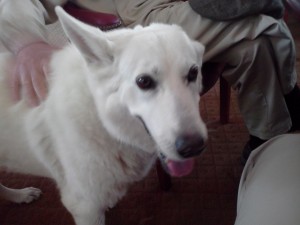
‘Sixty’ is always at Pete’s side. This is actually the 4th ‘Sixty’ so maybe nicknamed ‘Sixty-Three.’
4. The name of Pete’s dog is “Sixty” and comes from the original purchase. When Alice asked what should we name the dog, Pete responded how about the name “Sixty” because it cost him $60 (a lot of money at the time) – more than the advertised $20 for the dog, with an additional $20 for the collar and $20 for the leash to take him home with. This “Sixty” is really the fourth “Sixty.”
5. Pete Dye once said “The ardent golfer would play Mount Everest if somebody would put a flagstick on top… golf is not a fair game so why build a fair golf course?” Well, the Pete Dye Course at the French Lick Resort is high but it is not Mount Everest. There are 18 flagsticks mounted there and believe it or not it is a fair golf course. When you play the course the right side of the uphill par-5 15th fairway was recently raised 10 feet. It is still a blind shot but now you can see the top of the flagstick. Also look for a widening of the sixth fairway and raising of the left fairway bunkers as well to make it more playable for the average golfer no matter where he or she drives the ball.
Andy Reistetter is a freelance golf writer as well as a Spotter, Research and Broadcast Assistant for The Golf Channel, NBC and CBS Sports. He spends time on all four major American golf tours- the PGA TOUR, Champions, Web.com and LPGA tours.
Reistetter resides within two miles of the PGA TOUR headquarters and the home of The PLAYERS Championship at TPC Sawgrass in Ponte Vedra Beach.
A lifetime golfer, Andy enjoys volunteering at the World Golf Hall of Fame and THE PLAYERS while pursuing his passion for the game of golf and everything associated with it.
Friend Andy Reistetter on Facebook to enjoy daily updates on the Andy’s Golf & Travel Diary page or touch base with him by e-mail at AndyReistetter@gmail.com
